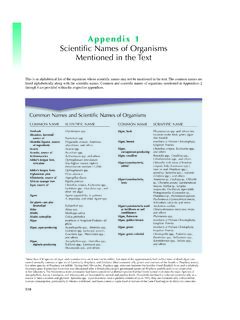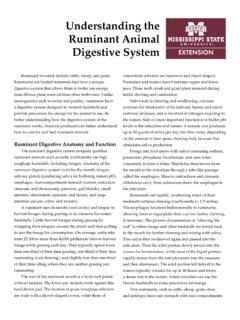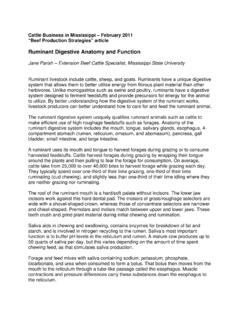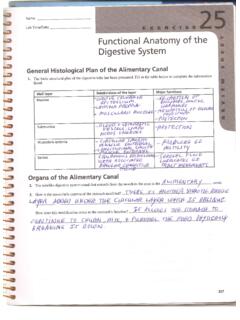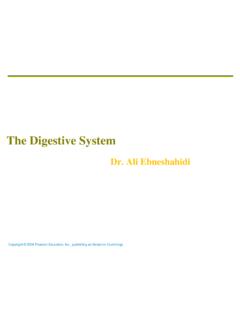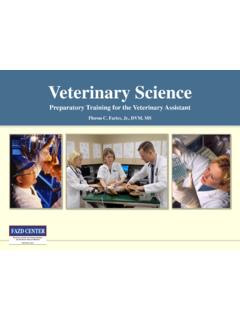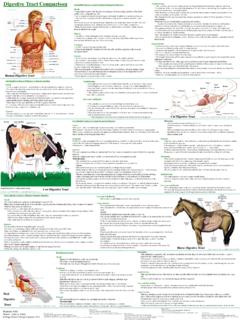Transcription of UNIT 10 - DIGESTIVE SYSTEM
1 Medical anatomy and Physiology unit Ten DIGESTIVE SYSTEM Page 1 Draft Copy unit 10 - DIGESTIVE SYSTEM LECTURE NOTES IDENTIFY THE GENERAL FUNCTIONS OF THE DIGESTIVE SYSTEM . The DIGESTIVE organs includes all organs involved with (1) digestion - the mechanical and chemical breakdown of food into a usable form, (2) absorption - the movement of molecules through the mucosal lining and into the blood, and (3) excretion - the removal of solid waste. Other associated processes include ingestion or the intake of nutrients and the movement through peristalsis. CONTRAST CHEMICAL AND MECHANICAL DIGESTION A. Chemical Digestion Catabolic reactions which break down carbohydrates, proteins, and lipids into their building blocks of monosaccharides, amino acids, and fatty acids and glycerol.
2 Requires enzymes to speed up the chemical reactions. B. Mechanical Digestion The breaking down of the bigger pieces of food to smaller pieces of food by chewing (mastication) or maceration. DIFFERENTIATE BETWEEN THE ALIMENTARY CANAL AND ACCESSORY ORGANS A. The Alimentary Canal The alimentary canal is a continuous tube running through the middle of the body from the mouth to the anus. The food and/or waste products move through these organs. The organs include the mouth, pharynx, esophagus, stomach, small intestine, large intestine, and anus. B. Accessory Organs The accessory organs include those organs which provide enzymes, hormones, and fluids to break down food, and do not have direct contact with the food.
3 These include the salivary glands, liver, gallbladder, and pancreas. The largest salivary glands, the parotid glands are located just anterior to the ear, under the masseter muscle. DEFINE THE FUNCTIONS OF SALIVA AND SALIVARY AMYLASE IN DIGESTION. A. Saliva 1. Saliva is the fluid secreted by the salivary glands. It flows from the salivary glands through ducts into the mouth. Medical anatomy and Physiology unit Ten DIGESTIVE SYSTEM Page 2 Draft Copy 2. Composition of Saliva. a. Saliva is water b. of the solutes include bicarbonate ions, mucin, and salivary amylase. B. Salivary amylase is the enzyme which chemically breakdown starch into maltose in the mouth.
4 IDENTIFY THE PARTS OF A TYPICAL TOOTH. A. Crown The crown is the exposed portion of the tooth - found above the gums. B. Neck The neck is the constricted junction line of the tooth between the crown and the root. C. Root The root contains one to three projections of the tooth which embedded in the sockets of the alveolar processes of the mandible and the maxillae. D. Gingiva The gingiva is another name for the gums which surround the tooth. E. Periodontal Ligament The periodontal ligament is an area of dense fibrous connective tissue attached to the socket walls and the cemental surfaces of the roots of the tooth. It anchors the tooth in position and absorbs shock during chewing. F.
5 Enamel The enamel is the portion of the tooth that protects the teeth from wear and tear. It is the hardest substance in the body. It is composed primarily of calcium phosphate and calcium carbonate and covers the crown. G. Dentin The dentin is calcified connective tissue, (bony part of the tooth) which gives the tooth its basic shape and rigidity H. Pulp The pulp cavity is a large cavity enclosed by the dentin and filled with fleshy material known as pulp. It contains the nerves and blood vessels. I. Root Canal Openings within the roots of the teeth which allow for the passage of nerves and blood vessels into and out of the pulp cavity. Medical anatomy and Physiology unit Ten DIGESTIVE SYSTEM Page 3 Draft Copy DIGESTIVE PROCESSES A.
6 Deglutition Deglutition or swallowing is the mechanism that moves food from the mouth, through the pharynx, and into the esophagus. B. Mastication Mastication or chewing breaks food down into smaller pieces by combining it with saliva. As the food and saliva mix, a ball of food called a bolus is formed. C. Maceration Maceration are mixing waves in the stomach which mix food with the gastric secretions to form a liquid paste called chyme. D. Segmentation Segmentation is a strictly localized contraction of the small intestine to mix food with DIGESTIVE juices. It happens in areas of the small intestine containing food and brings chyme in contact with the mucosa for absorption. E. Peristalsis Peristalsis is the wave-like smooth muscle contractions of the muscularis layer which propel food and wastes along the alimentary canal.
7 F. Haustral Churning Haustral churning is the way the large intestine moves food. A haustrum, or intestinal pouch, remains relaxed until it fills up, then it contracts moving food to the next haustrum. IDENTIFY THE ANATOMICAL FEATURES OF THE STOMACH The stomach is a J-shaped pouch located inferior to the diaphragm in the left upper quadrant. It is located between the esophagus and the small intestine and is part of the alimentary canal. A. Fundus The fundus is the rounded superior area of the stomach that acts as a temporary storage for food B. Body The body is the large, central portion of the stomach below the fundus. C. Pylorus The pylorus is the narrow, inferior region of the stomach. Medical anatomy and Physiology unit Ten DIGESTIVE SYSTEM Page 4 Draft Copy D.
8 Rugae Rugae are folds of the mucosa which stretch to increase the size of the stomach. E. Cardiac Sphincter The cardiac sphincter or the cardiac opening is where the stomach and the esophagus join. F. Pyloric Sphincter The pyloric sphincter is the opening from the pylorus of the stomach into the duodenum of the small intestine. THE BASIC COMPONENTS OF GASTRIC JUICE A. Pepsin Pepsin is an enzyme secreted in its inactive form pepsinogen. It is activated by the presence of hydrochloric acid. It facilitates the chemical digestion of proteins into dipeptides. B. Hydrochloric Acid Hydrochloric acid provides the acidic environment needed for the enzyme action in the stomach. C. Mucus Mucus is a thick, sticky substance which helps protect the inner lining of the stomach.
9 THE LOCATION AND DIGESTIVE FUNCTIONS OF THE PANCREAS A. Anatomical Description 1. The pancreas is located in the left upper quadrant, posterior to the stomach. 2. The pancreas is an endocrine gland since its specialized islet cells produce the hormones insulin and glucagon. 3. The pancreas is an exocrine gland since its specialized acinar cells produce DIGESTIVE enzymes which are released through ducts into the duodenum of the small intestine. B. DIGESTIVE Physiology 1. Pancreatic juice includes secretions which are made by the pancreas including DIGESTIVE enzymes and bicarbonate ions to increase the pH of the acidic chyme. It is necessary to increase the pH as the chyme flows into the duodenum.
10 2. Pancreatic juice flows through the pancreatic duct, through the hepatopancreatic sphincter and into the duodenum. Medical anatomy and Physiology unit Ten DIGESTIVE SYSTEM Page 5 Draft Copy 3. It helps to chemically digest organic compounds including carbohydrates, lipids, and proteins. DESCRIBE THE FUNCTION OF BILE (EMULSIFICATION) A. Bile is a greenish-colored fluid which Is produced in the liver. The principle pigment in bile is bilirubin. B. Bile is typically stored and concentrated in the gallbladder and flows to the duodenum when stimulated by the presence of fat. C. Bile functions to emulsify fat to aid in lipid digestion by assisting in mechanical digestion or breaking the fat into smaller pieces to increase the surface area available for DIGESTIVE enzymes to work.

